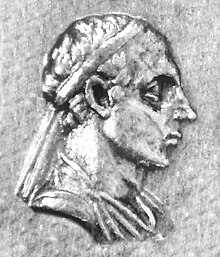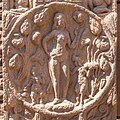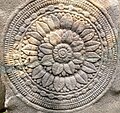پادشاهی یونانی هند
این مقاله میتواند با ترجمهٔ متن از مقالهٔ متناظر در انگلیسی گسترش یابد. برای مشاهدهٔ دستورالعملهای مهم ترجمه روی [گسترش] کلیک کنید.
|
پادشاهی یونانی هند | |||||||||||||
|---|---|---|---|---|---|---|---|---|---|---|---|---|---|
| ۲۰۰ پ. م–۱۰ میلادی | |||||||||||||
قلمرو یونانیهای هند در حدود سال ۱۵۰ پ.م.[۱] | |||||||||||||
| پایتخت | الکساندریا (بگرام امروزی)[۲] تاکسیلا | ||||||||||||
| زبان(های) رایج | زبان یونانی کوینه (الفبای یونانی) زبان پالی (الفبای خروشتی) زبان سانسکریت پراکریت (الفبای براهمی) | ||||||||||||
| دین(ها) | آیین یونانی آیین یونانی - بودایی آیین یونانی ترکیب شده با دیگر آیینهای بومی آیین بودایی آیین هندویی آیین زرتشتی | ||||||||||||
| حکومت | پادشاهی | ||||||||||||
| باسیلئوس | |||||||||||||
• ۲۰۰ – ۱۸۰ پ. م | دمتریوس یکم (اولین) | ||||||||||||
• ۲۵ پ. م – ۱۰ میلادی | استراتو سوم (آخرین) | ||||||||||||
| دوره تاریخی | دوران باستان | ||||||||||||
• بنیانگذاری | ۲۰۰ پ. م | ||||||||||||
• فروپاشی | ۱۰ میلادی | ||||||||||||
| مساحت | |||||||||||||
| ۱۵۰ پ. م[۳] | ۱٬۱۰۰٬۰۰۰ کیلومتر مربع (۴۲۰٬۰۰۰ مایل مربع) | ||||||||||||
| |||||||||||||
| امروز بخشی از | افغانستان پاکستان هند | ||||||||||||
| پادشاهی یونانی هند (۲۰۰پ.م–۱۰ میلادی) | ||||||||||||||||||||||||||||||||||||||||||||||
|---|---|---|---|---|---|---|---|---|---|---|---|---|---|---|---|---|---|---|---|---|---|---|---|---|---|---|---|---|---|---|---|---|---|---|---|---|---|---|---|---|---|---|---|---|---|---|
|
||||||||||||||||||||||||||||||||||||||||||||||
| بخشی از مجموعه |
| پادشاهی یونانی هند |
|---|
 |

پادشاهی یونانی هند یا پادشاهی یونانی- هندی، که از نظر تاریخی با نام پادشاهی یاوانا (Yavanarajya) نیز شناخته میشود،[۴] یک پادشاهی یونانی دوران هلنی بود که بخشهای مختلف افغانستان، پاکستان و شمال غربی هند امروزی را پوشش میداد.[۵][۶][۷][۸][۹][۱۰] این پادشاهی از سال ۲۰۰ پ. م تا ۱۰ میلادی وجود داشت.
این پادشاهی در طول عمر خود توسط ۳۰ پادشاه متوالی اداره شد. مناندر یکم، از مشهورترین پادشاهان این دودمان است، پایتخت مناندر یکم در شهر ساگالا در پنجاب (سیالکوت امروزی) است.[۱۱]
این پادشاهی در زمانی تأسیس شد که پادشاه باکتریا، دمتریوس یکم (و بعداً اوکراتیدس) در سال ۲۰۰ پ. م از باکتریا به هند حمله کردند.[۱۲] یونانیهای ساکن در شبهقاره هند، در نهایت از پادشاهی یونانی باکتریا مستقل شده و پادشاهی یونانی هند را، در شمال شبهقاره هند بوجود آوردند.[۱۳]
پادشاهان یونانی در طول دو قرن حکومت خود، زبانها و نمادهای یونانی و هندی را، همانطور که از روی سکههایشان دیده میشود، با هم ترکیب کردند و اندیشههای یونانی و هندی (مانند آیین یونانی و بودایی) را، آنگونه که در بقایای باستانشناسی مشاهده میشود، باهم در هم آمیختند.[۱۴] انتشار فرهنگ یونانی و هندی نتایجی داشت که امروزه نیز به ویژه از طریق تأثیر بر هنر یونانی و بودایی قابل مشاهده است.[۱۵] نژاد یونانی و هندی ممکن است تا حدی ترکیبی بوده باشد. به گفته پولیبیوس، اوتیدموس یکم،[۱۶] یک یونانی اهل ماگنزیا بود. پسر او، دمتریوس یکم، بنیانگذار پادشاهی یونانی هند نیز، حداقل از نظر پدرش از یونانی نژاد بود. به همین منظور نیز دمتریوس با دختر فرمانروای سلوکی، آنتیوخوس سوم ازدواج کرد. نژاد فرمانروایان بعدی یونانیهای هند، گاهی کمتر مشخص است.[۱۷] به عنوان مثال، در گذشته تصور میشد که آرتمیدوروس (۸۰ پ. م) یکی از پادشاهان یونانی هند، دارای تباری سکایی باشد، اما امروزه او را، به عنوان یک پادشاه یونانی - هندی در نظر میگیرند.[۱۸]
پس از مرگ مناندر، بیشتر پادشاهی او از هم پاشید و نفوذ یونانیها به میزان قابل توجهی کاهش یافت. بسیاری از پادشاهیها و جمهوریهای جدید در شرق رودخانه راوی شروع به ضرب سکههای جدیدی کردند که پیروزیهای نظامیشان را نشان میداد.[۱۹] برجستهترین حکومتهایی که تشکیل شدند، جمهوری یائودههیا، آرجونآیاناس و آدومباراس بودند.[۲۰] دودمانهای داتا و میترا نیز، به سرعت در منطقه ماتورا گسترش یافتند. یونانیها در نهایت به عنوان یک موجودیت سیاسی تا حدود سال ۱۰ میلادی دوام آوردند، اما دنبال حملههای سکاها حکومتشان از بین رفت، اگرچه جمعیت یونانیها احتمالاً برای چندین قرن، زیرنظر حکومتهای بعدی، بمانند: سکاییهای هند، اشکانیهای هند و کوشانیها، در آن سرزمین زندگی کردند.[الف]
نگارخانه[ویرایش]
جستارهای وابسته[ویرایش]
- هلنیسم
- گاهشمار پادشاهی یونانی هند
- تجارت روم
- تقسیم شدن امپراتوری اسکندر مقدونی
- پادشاهی یونانی باکتریا
- پادشاهی سکایی هند
- عصر هلنی
- امپراتوری سلوکی
- زبان باکتریایی
- زبان یونانی کوین
یادداشت[ویرایش]
- ↑ "زمانی که یونانیهای باکتریا و هند، پادشاهی خود را از دست دادند، نه همهٔ آنها کشته شدند و نه به یونان بازگشتند. آنها با مردم بومی منطقه ادغام شده و برای حاکمان جدید کار کردند. آنها کمک قابل توجهی به پیشرفت فرهنگ و تمدن در جنوب و مرکز آسیا کردند." Narain, "The Indo-Greeks" 2003, p. 278
منابع[ویرایش]
- ↑ Schwartzberg, Joseph E. (1978). A Historical atlas of South Asia. Chicago: University of Chicago Press. p. 145, map XIV.1 (d). ISBN 0-226-74221-0.
- ↑ Tarn, William Woodthorpe (1966), "Alexandria of the Caucasus and Kapisa", The Greeks in Bactria and India, Cambridge University Press, pp. 460–462, doi:10.1017/CBO9780511707353.019, ISBN 978-0-511-70735-3
- ↑ Taagepera, Rein (1979). "Size and Duration of Empires: Growth-Decline Curves, 600 B.C. to 600 A.D.". Social Science History. 3 (3/4): 132. doi:10.2307/1170959. JSTOR 1170959.
- ↑ Wilson, John (1877). Indian Caste (به انگلیسی). Times of India Office. p. 353.
- ↑ Jackson J. Spielvogel (14 September 2016). Western Civilization: Volume A: To 1500. Cengage Learning. p. 96. ISBN 978-1-305-95281-2.
The invasion of India by a Greco-Bactrian army in … led to the creation of an Indo-Greek kingdom in northwestern India (present-day India and Pakistan).
- ↑ Erik Zürcher (1962). Buddhism: its origin and spread in words, maps, and pictures. St Martin's Press. p. 45.
Three phases must be distinguished, (a) The Greek rulers of Bactria (the Oxus region) expand their power to the south, conquer Afghanistan and considerable parts of north-western India, and establish an Indo-Greek kingdom in the Panjab where they rule as 'kings of India'; i
- ↑ Heidi Roupp (4 March 2015). Teaching World History: A Resource Book. Routledge. p. 171. ISBN 978-1-317-45893-7.
There were later Indo-Greek kingdoms in northwest India. ...
- ↑ Hermann Kulke; Dietmar Rothermund (2004). A History of India. Psychology Press. p. 74. ISBN 978-0-415-32919-4.
They are referred to as 'Indo-Greeks' and there were about forty such kings and rulers who controlled large areas of northwestern India and Afghanistan. Their history ...
- ↑ Los Angeles County Museum of Art; Pratapaditya Pal (1986). Indian Sculpture: Circa 500 B.C. -A.D. 700. University of California Press. p. 15. ISBN 978-0-520-05991-7.
Since parts of their territories comprised northwestern India, these later rulers of Greek origin are generally referred to as Indo-Greeks.
- ↑ Joan Aruz; Elisabetta Valtz Fino (2012). Afghanistan: Forging Civilizations Along the Silk Road. Metropolitan Museum of Art. p. 42. ISBN 978-1-58839-452-1.
The existence of Greek kingdoms in Central Asia and northwestern India after Alexander's conquests had been known for a long time from a few fragmentary texts from Greek and Latin classical sources and from allusions in contemporary Chinese chronicles and later Indian texts.
- ↑ Tarn, William Woodthorpe (2010-06-24). The Greeks in Bactria and India (به انگلیسی). Cambridge University Press. p. 247. ISBN 978-1-108-00941-6.
- ↑ Thonemann, Peter (2016-01-14). The Hellenistic World: Using Coins as Sources (به انگلیسی). Cambridge University Press. p. 97. ISBN 978-1-316-43229-7.
- ↑ "Indo-Greek Campaigns".
- ↑ "A vast hoard of coins, with a mixture of Greek profiles and Indian symbols, along with interesting sculptures and some monumental remains from Taxila, Sirkap and Sirsukh, point to a rich fusion of Indian and Hellenistic influences", India, the Ancient Past, Burjor Avari, p. 130
- ↑ Ghose, Sanujit (2011). "Cultural links between India and the Greco-Roman world". Ancient History Encyclopedia
- ↑ 11.34
- ↑ ("Notes on Hellenism in Bactria and India". W. W. Tarn. Journal of Hellenic Studies, Vol. 22 (1902), pp. 268–293).
- ↑ Osmund Bopearachchi Was Indo-Greek Artemidoros the son of Indo-Sctythian Maues
- ↑ "Most of the people east of the Ravi already noticed as within Menander's empire -Audumbaras, Trigartas, Kunindas, Yaudheyas, Arjunayanas- began to coins in the first century BC, which means that they had become independent kingdoms or republics.", Tarn, The Greeks in Bactria and India
- ↑ Tarn, William Woodthorpe (2010-06-24). The Greeks in Bactria and India. ISBN 978-1-108-00941-6.
پیوند به بیرون[ویرایش]
| در ویکیانبار پروندههایی دربارهٔ پادشاهی یونانی هند موجود است. |
- تاریخ یونانیهای هند و سکههایشان
- سکههای باستانی، پادشاهیهای یونانی باکتریا و هند
- نوشتهی پروفسور نیکلاس سیمز ویلیامز (از دانشگاه لندن) برای اشاره به ورود کوشانیها و جایگزینی زبان یونانی.
- عکسهای بازآفرینی شده از واحدهای گوناگون ارتش یونانی هند.
- تأثیر فرهنگ یونانی - هندی بر تمدن غرب
- چند فرضیه جدید در مورد پادشاهیهای یونانی باکتریا و هند توسط آنتونی سایمونین
- پادشاهیهای یونانی باکتریا و هند در متون باستانی
- اقوام در هند
- انحلالهای دهه ۱۰ (میلادی)
- انحلالهای سده ۱ (میلادی)
- ایالتها و قلمروهای بنیانگذاریشده در سده ۲ (پیش از میلاد)
- ایالتها و قلمروهای منحلشده در سده ۱ (میلادی)
- بنیانگذاریهای دهه ۱۸۰ (پیش از میلاد)
- پادشاهیهای سابق
- تاریخ افغانستان
- تاریخ باستان افغانستان
- تاریخ هند
- دولتهای یونانی
- مردمان باستانی پاکستان
- هند باستان








